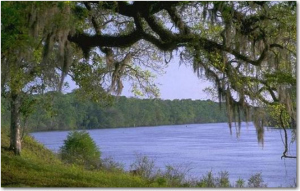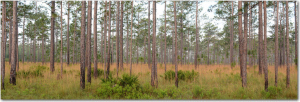On Location: the Apalachicola River

Near Ft. Gadsden – U.S. Dept of Agriculture photo on Flickr
The Apalachicola River in the Florida Panhandle is created at the Georgia border by the Flint and Chattahoochee rivers and then flows 112 miles to the Gulf of Mexico. The river has been in the news in recent years as Florida, Georgia and Alabama fight over who owns the water. Atlanta takes more than its fair share, some say, starving natural areas North to South down the panhandle and, worse yet, the fragile ecosystem of Apalachicola Bay.
From the air, there are places where the river looks like a very large green snake because it twists and turns and almost coils back on itself. The ecosystems have been under stress for years. The river has been improperly dredged; the pine forests have been over logged and–when it comes to longleaf pines–poorly managed; roads to the timber have blocked natural water flows through swamps and other wetlands. The rare Florida Panther can no longer be found in the river’s watershed.
The Apalachicola River was the western boundary of my childhood, for we camped along its banks and on the barrier islands protecting the bay, sailed from its mouth to and from Alligator Point and the St. Marks River to the east, drove or walked every forest service road from Tallahassee to Tate’s Hell Forest (near the mouth of the river at Carrabelle), and experienced one of the most unique ecosystems in the country.
The Apalachicola Riverkeeper says that the river’s basin is home to 127 very rare plant and animal species along with more reptiles and amphibians than any other place in the in the northern hemisphere. The river is not only a resource many habitats, but also for kayakers, fishermen, paddle boaters, swimmers, photographers and–in the bay–a very large fishing industry.

Pine flatwoods, typical of much of the areas national forests
I’ve always been rather jealous of those who knew every plant in the swamp and forest as well as those who knew how to chart river flows, analyze soil and restore forest lands. The Nature Conservancy is at work in this area, trying to undo many years of damage while protecting lands from more “development.” Since I’m not a scientist or a naturalist, I try to focus on natural resources in my fiction. It’s my way of drawing attention to the environment.
Lately, I’ve been at work on a novella set in a fictional town a few miles from the Apalachicola River in Liberty County, the Florida county with the lowest population. In many ways it’s like going home to look at these areas again and put them into stories. I recently finished reading a political thriller novel called Mercedes Wore Black (which I review here.) The main character is an environmental reporter, making the book a very strong window framing Florida’s ongoing developers vs. the environment battles.
The author of that book lived in Florida more recently than I have and as a long-time reporter, she could focus more clearly on the issues from a practical standpoint. I try to focus on the locations and make readers aware of the ecosystems’ value in the scheme of things without getting into many political rants.
Some of my poet friends write poems about the environment. Photographers are taking pictures of things the way they are while hoping they won’t become the way they were. I’m pleased at the number of groups, blogs, Facebook pages and initiatives that are campaigning for various ways to save the land before we ruin it all.

Click on the photo to learn more about the river and the threats to it.
I’m not a political activist, though I’ve dabbled in it from time to time. My focus is fiction. Many of my readers’ focus is travel and outdoor recreation, often with a spiritual component. If you’re a writer, you can “go on location” in a dozen ways to pinpoint natural resources and the need to keep them natural.
There are times when I think that the land itself is an important “character” in my novels and stories. If the land draws you, then your pen, camera, blog and voice can help preserve it.
You May Also Like:
The Nature Conservancy’s Apalachicola Bluffs and Ravines Preserve
Tate’s Hell Forerst restoration plan
Apalachicola River Paddling Trail System
Malcolm R. Campbell’s novel “The Seeker” is partially set in Tate’s Hell Forest, while his short stories “The Land Between the Rivers,” “Emily’s Stories,” “Cora’s Crossing” and “Moonlight and Ghosts” also have Florida settings.





